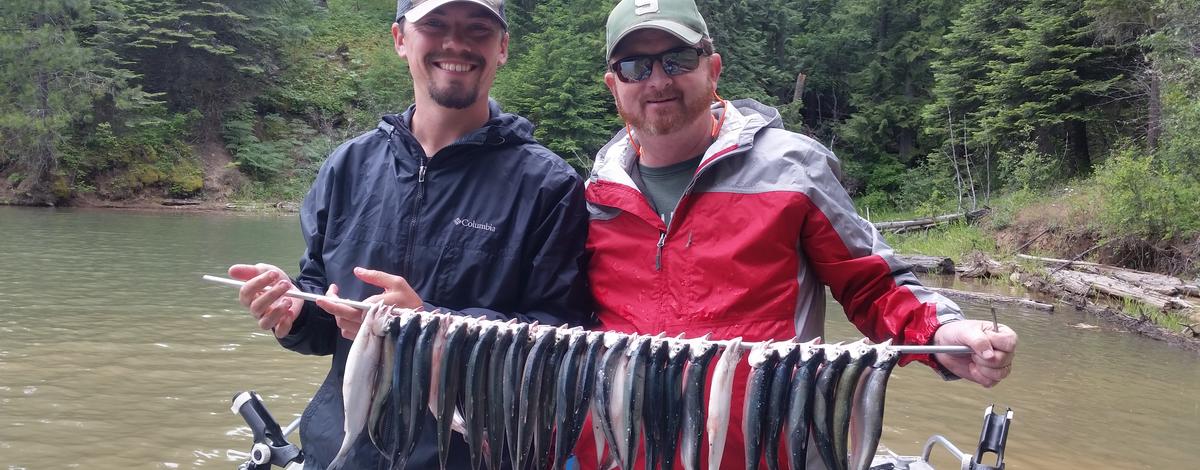It’s been quite a while since we’ve had a winter like this past one. But spring is here, the weather is warming and anglers are getting out on Dworshak Reservoir to chase bluebacks, smallies, or whatever else may bite.
Dworshak is one of the most popular fisheries in the Clearwater Region, and here’s how the fishery is shaping up.
Kokanee
Last season was a great year for kokanee anglers. There were more kokanee than typical, but of average size. A higher than average number of two year old fish resulted in one of the highest catch rates documented in the last 30 years. There was also a record number of larger, three year old fish.
Catches like the one pictured below were common for several hours of fishing. This year there could be a typical number of kokanee, but of above average size. We expect there will be approximately 210,000 two year old kokanee, which is very close to the average two year old fish abundance since 2000.
In addition, about three percent of the two year old fish from last year could carry over as three year old fish, which would be a little over 10,000 fish. If this is the case, anglers could expect to catch one larger three year-old fish in each limit of 25.
One unknown this year is how many kokanee were entrained - lost through the dam. High entrainment would mean lower than average survival, and fewer fish than expected. Heavy snowpack resulted in the Corps of Engineers releasing high volumes of water out of the dam this spring.
While we did see evidence of a couple of entrainment events in late April, they appear to have been short in duration. We won’t know for sure until our surveys in late July, but at this point it appears we’ll still have plenty of fish for a decent fishery.
While on Dworshak in early May, we marked very few fish on our sounder and the anglers we spoke to were having a hard time locating fish as well. While this may indicate a lack of fish in the reservoir, we noticed what few fish we marked were holding very shallow. Surface temperatures at the time were ideal for kokanee, meaning that many of the fish could have been holding close to the surface, where they are difficult to impossible to find with down looking sonar.
This happened last April as well, when the fish seemed to disappear for about a month, until water temperatures warmed enough to force the fish back down in the water column. Any fish that haven’t been flushed out of the reservoir this spring will be much easier to locate as the water warms.
Overall, while kokanee numbers may be down from last year, size is on the increase. Most fish are already above the long-term average of 10 inches, and they should be just starting to grow for the year. We have already measured fish over 12 inches, including one that was brought to a check station that was 14 inches. With good growth, we could see fish averaging 12 inches by summer.
Smallmouth
If you’re not a kokanee fisherman, there are still plenty of reasons to fish Dworshak. Bass fishing has been good the last two years, and this year is shaping up to be more of the same.
Water temperatures have been cooler this spring, compared to the last two years, and larger fish moved into shallow water on the lower end of the reservoir by late April. As a result, the fishing has been slow, but the fish caught have been larger than average.
The smallmouth we checked in April averaged over 15 inches long, with some over 18 inches. As the water continues to warm, the larger fish will move into deeper water and smaller fish will move up along the banks. As this happens, catch rates will pick up, but average size will go down. Water temperatures have been much cooler on the upper end of the reservoir, so these movements will be happening over the next few weeks.
Even with cooler temperatures and some tougher angling conditions this spring, some dandy smallmouth continue to be caught. Anglers fishing a tournament at the end of April did quite well, with most anglers returning with limits of medium to large fish.

